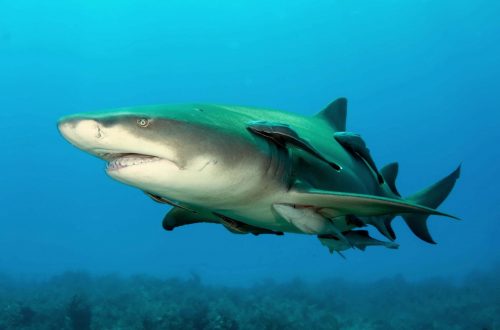
Negaprion brevirostris
The lemon shark is easily recognized for its two, equally-sized dorsal fins and its yellow-brown to olive color- an ideal camouflage against the sandy in-shore areas they prefer to forage in. Lemon sharks average between 8 to 10 feet long as adults, but are generally not considered a threat to humans. They are social animals that can be seen in aggregations and prefer a defined home range. Lemon sharks are commonly exhibited in aquaria and research studies (Compagno et al. 2005, Sundström 2015).
Order: Carcharhiniformes
Family: Carcharhinidae
Genus: Negaprion
Species: brevirostris
Common Names
The lemon shark gets its name because of its pale yellow-brown coloring. It is also known as:
requin citron (French)
kurznasenhai (German)
zitronenhai (German)
squalo limone (Italian)
cacao-limao (Portuguese)
tiburon galano (Spanish)
citronhaj (Swedish)
ceq (Wolof)
Importance to Humans
The lemon shark is targeted by commercial and recreational fisheries along the US Atlantic Ocean, Caribbean, and in the eastern Pacific Ocean. The US bottom longline fishery commonly targets this species and it is also caught as by-catch in both pelagic and gillnet fisheries. The meat is consumed in Central America, South America, and the US. Their fins are highly prized and exported to Asia for shark fin soup and their skin is used for leather.
Danger to Humans
Lemon sharks represent little threat to humans. According to the International Shark Attack File, there have been only 10 unprovoked attacks by lemon sharks, all occurring in Florida and the Caribbean. There have been no fatal attacks attributed to this species. The lemon shark inhabits coastal waters in close proximity to swimmers, surfers and divers. While the number of attacks attributed to this species is low caution is still warranted as they are a large predatory species (ISAF 2018).
View shark attacks by species on a world mapConservation
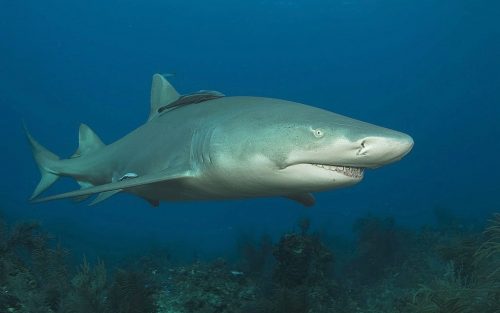
IUCN Red List Status: Near Threatened
There are currently no management plans in place specifically for the lemon shark (Sundström 2015). The Highly Migratory Species Division of the National Marine Fisheries Service manages shark species in US Atlantic waters. Lemon sharks are part of an aggregate of sharks, that are managed collectively as a single group creferred to as “the large coastal sharks”. Currently, they are monitored through a quota and seasonal based management plan (NMFS). The International Union for Conservation of Nature and Natural Resources (IUCN) rates this species as “Near Threatened”. Some scientists believe that the lemon shark population has been depleted in recent years, specifically in Florida waters (Sundström 2015).
> Check the status of the lemon shark at the IUCN website.
The IUCN is a global union of states, governmental agencies, and non-governmental organizations in a partnership that assesses the conservation status of species.
Geographical Distribution
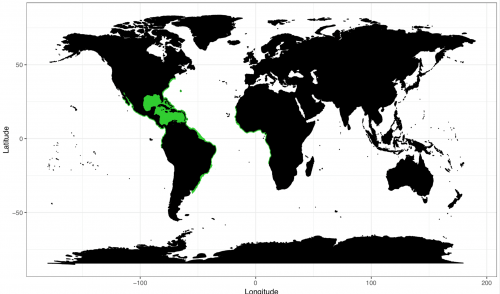
Lemon sharks inhabit coastal inshore waters from New Jersey (US) to Southern Brazil, Gulf of Mexico and Caribbean in the northwestern Atlantic Ocean and along Senegal and the Ivory Coast of Africa in the eastern Atlantic. It is unknown whether the eastern and western Atlantic individuals are the same species. In the North Pacific, the lemon shark ranges from the Gulf of California and Baja California south to Ecuador (Sundström 2015).
Habitat
The lemon shark is commonly found in subtropical shallow water to depths of 300 feet (90 m) around coral reefs, mangroves, enclosed bays, sounds and river mouths. However, this species do not venture far into freshwater systems. Lemon sharks can be found in oceanic water when migrating but tend to stay along the continental and insular shelves. The lemon shark is known to form loose aggregations based on size and sex and have been seen congregating near docks and fishing piers during the night, returning to deep water during the day (Compagno et al. 2005, Sundström 2015).
Distinguishing Characteristics
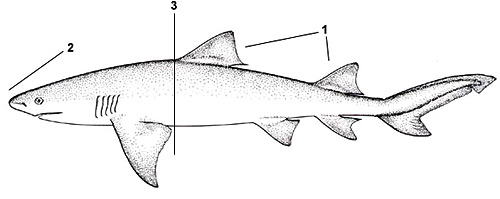
1. First and second dorsal fins are triangular and close to the same size
2. Snout is blunt and shorter than the width of the mouth
3. The first dorsal fin originates behind the pectoral fins
Biology
Distinctive Features
The lemon shark is a large stocky, blunt nosed shark with two dorsal fins of similar size. The first dorsal fin is low and positioned posterior to the pectoral fins, the second dorsal is of similar shape and size and positioned anterior to the origin of the anal fin. The pelvic fin has weakly concave rear margins and the pectoral fin outer margin is slightly convex. Both the pelvic and pectoral fins are weakly falcate. The snout is round and shorter than the width of the mouth. There is no mid-dorsal ridge present on this species (Compagno et al. 2005).
Coloration
The lemon shark has a yellow/brown or olive gray coloration on the dorsal surface and a pale yellowish-white color on the underside. There are no conspicuous markings.
Dentition
The upper teeth are narrow and broad with triangular smooth-edged cusps and finely serrated bases. The teeth become more oblique toward the corner of the mouth. The lower teeth are narrow and triangular with smooth-edged cusps (Bigelow and Schroeder 1948).
Denticles
Lemon shark dermal denticles are large and overlapping with 3 to 5 ridges. The median ridge is high, sharp and separated by deep furrows, and the posterior margins are opposite the primary ridges. The basal plates and pedicels are broad (Bigelow and Schroeder 1948).
Size, Age, and Growth
Lemon sharks are one of the larger species of sharks, commonly obtaining lengths between 250-300 cms (8 to 10 feet) and can weigh up to 250 kgs (551 lbs). Females and males reach sexual maturity around 12-13 years of age and at about 235 cm for females and 225 cm for males. Pups are born around 50-60 cm in length (Sundström 2015). Maximum life expectancy is about 27 years (Compagno et al. 2005).
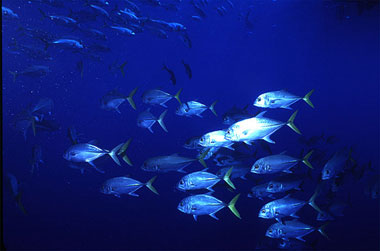
Food Habits
The lemon shark is commonly found swimming over sandy or muddy bottoms and eats a diet consisting mainly of bony fish and crustaceans. Catfish, mullet, jacks, croakers, porcupine fish, cowfish, guitarfish, stingrays, eagle rays, crabs and crayfish make up the majority of their diet. In addition, this species will eat sea birds and smaller sharks. Lemon sharks will eat until full with the rate of digestion dependent on the amount of food consumed at a single time (Sundström 2015).
Reproduction
Lemon shark pups are nourished via a placental connection to the mother and are born alive. Mating occurs in shallow water during the spring and summer months and is followed by a 10-12 month gestation period. Gravid females return to shallow nursery grounds to give birth and the young remain in these nursery grounds for several years. Litters range from 4-17 individuals and from 50-60 cm in length at birth (Compagno et al. 2005, Sundström 2015).
Predators
Larger sharks prey upon juvenile lemon sharks, but adult animals have few if any predators.
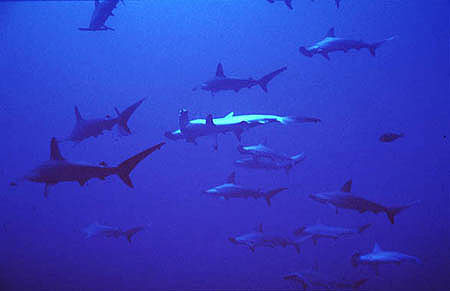
Parasites
Lemon sharks are a host to many parasites including copepods and monogeneans species. Dermophithirius nigrelli is a parasite known to cause skin lesions on lemon sharks (Cheung et al. 1982). In addition, Nemesis pilosus, Paralebion elongatus, Alebion carchariae, Perissopus dentatus, Nesippus orientalis, and Kroyeria spatulata are all copepods that are parasitic on lemon sharks.
Taxonomy
Poey first described the lemon shark in 1868 and named it Hypoprion brevirostris, later renaming it Negaprion brevirostris. The lemon shark has also appeared in literature as Negaprion fronto and Carcharias fronto Jordan and Gilbert, 1882, Carcharias brevirostris Gunther 1870, and Carcharhinus brevirostris Henshall 1891.
References
BIGELOW, H.B. & SCHROEDER, W.C. (1948). Fishes of the western North Atlantic, Part I: Lancelets, Cyclostomes, Sharks. Memoirs of the Sears Foundation for Marine Research, 1 (1): 59–576
CHEUNG, P. J., NIGRELLI, R. F., RUGGIERI, G. D. and CILIA, A. (1982), Treatment of skin lesions in captive lemon sharks, Negaprion brevirostris (Poey), caused by monogeneans (Dermophthirius sp.). Journal of Fish Diseases, 5: 167-170.
Compagno, L., Dando, M., & Fowler, S. (2005). A Field Guide to the Sharks of the World. London: Harper Collins Publishers Ltd.
Sundström, L.F. 2015. Negaprion brevirostris. The IUCN Red List of Threatened Species 2015: e.T39380A81769233.
Revised by Lindsay French and Gavin Naylor 2018
Original preparation by Alexia Morgan

